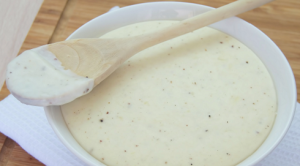A flavorful Asian Shrimp Stock can be a game changer in your culinary journey. It’s a simple recipe, but the result is a rich, aromatic base that lifts your soups, stews, and seafood dishes to a whole new level of deliciousness.
This recipe employs ingredients like shrimp heads and shells, rice wine, and ginger which you might not typically have at home. The shrimp heads and shells are key to a flavorful stock, so make sure not to discard these when you buy fresh shrimps. Rice wine, a staple in Asian cuisine, can be found in the Asian or international food section of the supermarket. Fresh gingerroot is usually available in the produce section.
Ingredients for the Asian Shrimp Stock Recipe
Shells and heads of shrimp: These parts of the shrimp are typically discarded, but they contain a lot of flavor and are essential for this stock.
Scallions: Also known as green onions, these add a mild, sweet flavor.
Rice wine: A common ingredient in Asian cooking; it imparts a subtle sweetness to dishes.
Fresh gingerroot: Ginger gives the stock a distinctive spicy and aromatic flavor.
Garlic: Garlic adds depth of flavor and a savory punch to the stock.
Water: The base of any stock, it helps in extracting flavor from other ingredients.
One reader, Judie Snook says:





This Asian shrimp stock recipe is a game-changer! The flavors are rich and aromatic, and it adds an incredible depth to my dishes. It's easy to make and versatile, perfect for enhancing the taste of various Asian-inspired soups and stews. I highly recommend trying it out!
Key Techniques for Crafting Asian Shrimp Stock
How to prepare shrimp stock: This technique involves combining the shrimp shells and heads, scallions, rice wine, ginger, garlic, and water in a saucepan and slowly bringing it to a boil over medium heat.
How to strain stock: After boiling the ingredients, the stock needs to be strained through a colander lined with cheesecloth into another large pot, pressing on the ingredients and shaking them gently to extract the juices.
How to store stock: Once the stock is prepared, it can be used immediately or cooled quickly in an ice bath and stored for up to 3 days in the refrigerator or 6 months in the freezer.
How To Make Asian Shrimp Stock
Add deep, umami flavors to a number of dishes with this Asian shrimp stock. It’s made with fresh ginger and garlic boiled with rice wine.
Serves:
Ingredients
- 1lbshrimp shells
- 1lbshrimp heads
- 4scallions
- cuprice wine,or dry sherry
- 1fresh gingerroot,peeled
- 2garlic clove
- 8cupscold water,(2 quarts)
Instructions
-
Combine the shells and heads, scallions, rice wine, ginger, garlic, and water in a 4-quart saucepan and slowly bring to a boil over medium heat.
-
Reduce the heat to low and gently boil, partially covered, for 1 hour.
-
Strain through a colander lined with cheesecloth into another large pot, pressing on the ingredients and shaking them gently to extract the juices.
-
Use stock immediately or cool quickly in an ice bath. Enjoy!
Recipe Notes
Store up to 3 days in the refrigerator or 6 months in the freezer.
Nutrition
- Calories: 120.04kcal
- Fat: 1.63g
- Saturated Fat: 0.42g
- Trans Fat: 0.03g
- Monounsaturated Fat: 0.29g
- Polyunsaturated Fat: 0.47g
- Carbohydrates: 4.22g
- Fiber: 0.48g
- Sugar: 0.41g
- Protein: 21.01g
- Cholesterol: 190.51mg
- Sodium: 871.49mg
- Calcium: 101.74mg
- Potassium: 243.96mg
- Iron: 0.54mg
- Vitamin A: 86.65µg
- Vitamin C: 2.69mg
Crucial Technique for Enhancing Shrimp Stock Flavor
When making your Asian shrimp stock, it's crucial to remember that the shells and heads of the shrimp are packed with flavor. Don't discard them after peeling your shrimp. Instead, freeze them until you're ready to make your stock. This not only reduces waste but also allows you to extract maximum flavor when you're ready to make your stock. Additionally, simmering the stock on low heat helps to extract the flavors more effectively without making the stock cloudy.
Time-Saving Tips for Preparing Shrimp Stock
Prep ahead: Save time by preparing the shrimp shells and heads, scallions, ginger, and garlic in advance. Store them in an airtight container in the refrigerator until you're ready to make the stock.
Use a pressure cooker: If you're short on time, consider using a pressure cooker to make the shrimp stock. It can significantly reduce the cooking time while still extracting all the flavors from the ingredients.
Freeze for later: Make a large batch of shrimp stock and freeze it in smaller portions. This way, you'll have stock readily available for future recipes, saving you time in the long run.
Invest in a good strainer: Using a fine-mesh strainer or a chinois can help you strain the stock more efficiently, saving time and ensuring a clear, smooth liquid.
Multi-task: While the stock is simmering, use that time to prep other ingredients for your dish. This way, you can make the most of your time in the kitchen.
Substitute Ingredients For Asian Shrimp Stock Recipe
shells and heads of shrimp - Substitute with crab shells and heads: Crab shells and heads can provide a similar depth of flavor and richness to the stock.
rice wine - Substitute with dry sherry: Dry sherry can provide a similar depth of flavor and complexity to the stock.
fresh gingerroot - Substitute with galangal: Galangal has a similar aromatic and spicy flavor to ginger, adding a unique twist to the stock.
cold water - Substitute with vegetable broth: Vegetable broth can add a savory depth of flavor to the stock, enhancing its overall richness.
Best Way to Present Homemade Shrimp Stock
Elevate the broth: Strain the shrimp stock through a fine sieve to ensure a clear and refined texture, free from any impurities or particles. This will create a visually appealing and elegant base for your dish.
Garnish with fresh herbs: Sprinkle finely chopped cilantro or Thai basil over the shrimp stock to add a pop of color and a burst of fresh flavor. This will enhance the visual appeal and aromatic quality of the dish.
Serve in delicate vessels: Present the shrimp stock in porcelain soup bowls or Japanese ceramic ware to showcase the sophistication and attention to detail in your presentation.
Accompany with seafood: Serve the shrimp stock alongside a selection of fresh seafood, such as poached shrimp or delicate crab meat, to highlight the essence of the dish and provide a luxurious dining experience.
Incorporate Asian-inspired elements: Add a touch of authenticity by incorporating lemongrass or kaffir lime leaves as a garnish, infusing the dish with subtle Asian flavors and aromas.
Artful drizzling: Before serving, delicately drizzle a few drops of sesame oil over the shrimp stock to impart a hint of nuttiness and create an artistic presentation.
Use elegant serving utensils: Present the shrimp stock with chopsticks or ceramic spoons to elevate the dining experience and showcase attention to detail in the presentation.
Add a touch of heat: For a sophisticated twist, incorporate a small amount of chili oil or Szechuan peppercorns to add a subtle kick and complexity to the shrimp stock.
Essential Tools for Making Shrimp Stock
Saucepan: A saucepan is a deep cooking pan with a handle and a lid, used for cooking on the stovetop. It is perfect for simmering stocks and broths.
Colander: A colander is a bowl-shaped kitchen utensil with holes in it, used for draining foods such as pasta or rinsing vegetables.
Cheesecloth: Cheesecloth is a loose-woven gauze-like cotton cloth used primarily in cheese making and cooking. It is often used for straining liquids to achieve a clear, smooth consistency.
Proper Storage and Freezing Methods for Shrimp Stock
Let the shrimp stock cool completely before storing it in the refrigerator or freezer. To speed up the cooling process, you can place the pot of stock in an ice bath and stir occasionally until it reaches room temperature.
Once cooled, transfer the stock to an airtight container or a resealable plastic bag. If using a bag, make sure to remove as much air as possible before sealing to prevent freezer burn.
Label the container or bag with the date and the contents (Asian shrimp stock) for easy identification later.
Refrigerator storage: The stock can be stored in the refrigerator for up to 3 days. Keep it in the coldest part of the fridge, typically the back of the bottom shelf.
Freezer storage: For longer storage, freeze the stock for up to 6 months. Consider freezing the stock in smaller portions (e.g., 1-2 cups) for convenient use in recipes later on. You can use ice cube trays to freeze smaller amounts, then transfer the frozen stock cubes to a resealable bag for compact storage.
To thaw frozen shrimp stock, transfer it from the freezer to the refrigerator and let it thaw overnight. Alternatively, you can thaw the stock in a bowl of cold water, changing the water every 30 minutes until the stock is fully thawed.
Once thawed, use the stock within 1-2 days and do not refreeze it to maintain the best quality and flavor.
If you notice any off smells, flavors, or signs of spoilage, discard the stock immediately.
How to Reheat Leftover Shrimp Stock
Reheat the shrimp stock in a saucepan over medium-low heat, stirring occasionally, until it reaches the desired temperature. This method ensures even heating and prevents the stock from scorching or losing its delicate flavor.
If you have a large quantity of leftover shrimp stock, consider reheating it in batches. This allows for more control over the temperature and ensures that the stock heats through evenly.
To add an extra depth of flavor to your reheated shrimp stock, consider adding a few fresh aromatics such as sliced ginger, crushed garlic cloves, or chopped scallions. These ingredients will infuse the stock with additional flavor and aroma.
If you plan to use the reheated shrimp stock as a base for a soup or stew, you can reheat it directly in the pot along with the other ingredients. This allows the flavors to meld together and creates a more cohesive dish.
For a quick and easy reheating method, transfer the desired portion of shrimp stock to a microwave-safe container and heat it in the microwave in 30-second intervals, stirring between each interval, until it reaches the desired temperature. Be careful not to overheat the stock, as this can cause it to become bitter or lose its flavor.
If you have frozen your leftover shrimp stock, allow it to thaw in the refrigerator overnight before reheating. This ensures that the stock reheats evenly and maintains its original texture and flavor.
Fascinating Facts About Shrimp Stock
The Asian shrimp stock recipe is a versatile base for various Asian dishes, adding depth and complexity to soups, stews, and sauces. It is a great way to utilize shrimp shells and heads, reducing waste and maximizing flavor. Shrimp stock is rich in umami, enhancing the overall taste of the dish. Additionally, it can be easily stored in the refrigerator or freezer, allowing for convenient use in future culinary creations.
Is Making Shrimp Stock at Home Cost-Effective?
The cost-effectiveness of this Asian shrimp stock recipe is quite high, as it utilizes shrimp shells and heads, which are often discarded, along with simple, affordable ingredients. The approximate cost for a household of 4 people would be around $10-15, making it a budget-friendly option. The rich and flavorful stock can be used as a base for various Asian-inspired dishes, adding depth of flavor without the need for expensive ingredients. Overall Verdict: 9/10.
Is This Shrimp Stock Recipe Healthy?
The Asian shrimp stock recipe is relatively healthy, as it primarily consists of shrimp shells and heads, vegetables, and water. Here's a breakdown of the ingredients and their health benefits:
- Shrimp shells and heads: Rich in calcium, antioxidants, and other minerals
- Scallions: Low in calories and high in vitamins A, C, and K
- Rice wine: Adds flavor without significant health impact when used in moderation
- Ginger: Contains anti-inflammatory properties and aids digestion
- Garlic: Known for its antibacterial and immune-boosting properties
- Water: Essential for hydration and overall health
However, there are a few aspects of the recipe that could be improved to make it even healthier:
- Consider reducing the amount of rice wine or replacing it with a healthier alternative, such as rice vinegar, to lower the alcohol content
- Add more vegetables to the stock, such as carrots, celery, or mushrooms, to increase the nutrient density and flavor complexity
- Experiment with adding herbs and spices like lemongrass, cilantro, or star anise to enhance the flavor profile while providing additional health benefits
To further boost the nutritional value of the shrimp stock, you could:
- Incorporate seaweed or kelp to increase the iodine content, which is essential for thyroid function
- Add a small amount of turmeric, known for its anti-inflammatory and antioxidant properties
- Use organic or sustainably sourced shrimp shells and heads to minimize exposure to potential contaminants
By making these minor adjustments, you can create a delicious and nutritious Asian shrimp stock that serves as a foundation for a variety of healthy dishes.
Editor's Opinion on This Asian-Inspired Shrimp Stock
The Asian shrimp stock recipe is a classic and versatile base for a variety of Asian-inspired dishes. The combination of shrimp shells, scallions, ginger, and garlic creates a rich and flavorful stock that can elevate the taste of soups, stews, and seafood dishes. The use of rice wine adds depth and complexity to the stock, making it a valuable addition to any chef's repertoire. The stock can be used immediately or stored for future use, providing a convenient and delicious foundation for culinary creations.
Enhance Your Asian Shrimp Stock Recipe with These Unique Side Dishes:
Delicious Alternatives to asian shrimp stock recipe
Appetizers and Desserts That Complement asian shrimp stock recipe
Why trust this Asian Shrimp Stock Recipe:
This Asian shrimp stock recipe uses only the freshest shrimp shells and heads, combined with aromatic scallions, rice wine, gingerroot, and garlic. The slow boiling process allows for the full extraction of flavors, resulting in a rich and flavorful stock that can elevate any dish. Trust the expertise behind this recipe to deliver a culinary experience that will impress your taste buds and add depth to your cooking.
Was this page helpful?
Have your own special recipe to share? Submit Your Recipe Today!














